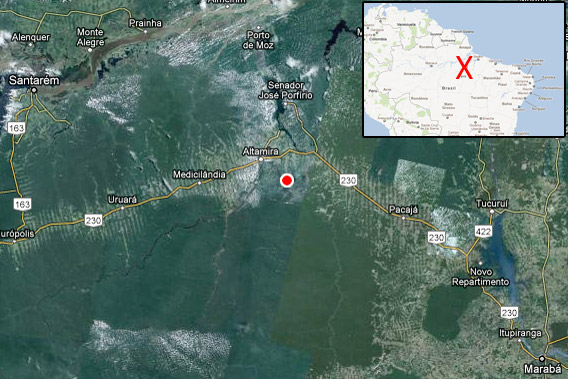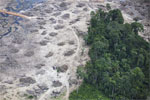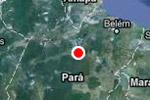
Belo Monte location. Courtesy of Google Earth.
Brazil’s National Development Bank (BNDES) on Monday announced it has approved a $10.8 billion (22.5 billion Brazilian reais) loan to the consortium that is building the controversial Belo Monte dam in the state of Par´ in the heart of the Amazon rainforest, reports International Rivers, a group that is campaigning against the dam. The loan in the largest in the bank’s 60-year history, according to the group.
Belo Monte is controversial on several grounds. Environmentalists and indigenous groups oppose the project for its potential social and environmental impacts, including forced displacement of river-dependent communities, inundation of tens of thousands of hectares of forest, and disruption of the Xingu River, one of the Amazon’s largest tributaries and home to a number of commercially-important fish species. The project will also generate substantial greenhouse gas emissions, according to Philip Fearnside, an Amazon expert at the Instituto Nacional de Pesquisas da Amazônia in Manaus, who calls the dam a “methane factory” due to its design flaws. Others have criticized the high costs of the dam, which is expected to operate at less than 40 percent of its capacity unless two more dams are built upstream. Finally some opponents have said the dam will drive deforestation in the surrounding area. Confirming these fears, in September it was revealed that Belo Sun, a subsidiary of a Candadian gold mining company, has already obtained rights to mine some 130,500 hectares near the dam site. The company says the redirection of 80 percent of the Xingu river will facilitate mining. Amazon Watch, an activist group fighting Belo Monte, says Belo Sun’s plans will “fling the doors open to additional mining operations and associated land invasions.”
Accordingly, nine Brazilian NGOs on Wednesday filed suit a petition with the Federal Public Prosecutor’s Office (Ministério Público Federal) in a bid to block the dam. The groups are aiming to block BNDES from disbursing dam payments.
Belo Monte has already been held up by several lawsuits, however the project is strongly supported by Brazilian President Dilma Rousseff, who championed the project prior to winning the presidency in 2010.
Related articles
Indigenous groups re-occupy Belo Monte dam in the Amazon
(10/09/2012) Construction on Brazil’s megadam, Belo Monte, has been halted again as around 150 demonstrators, most of them from nearby indigenous tribes, have occupied the main construction site at Pimental. Over a hundred indigenous people joined local fishermen who had been protesting the dam for 24 days straight. Indigenous people and local fishermen say the dam will devastate the Xingu River, upending their way of life.
Brazil’s controversial Belo Monte back on track after court decision overruled
(08/29/2012) Brazil’s Supreme Court on Tuesday ordered work on the controversial Belo Monte dam in the Amazon to resume, overturning a lower court order that suspended the project less than two weeks ago. Construction activities by the Norte Energia, the consortium building the dam, resumed immediately, according to the Associated Press.
Indigenous leaders demand suspension of Belo Monte dam
(07/10/2012) Indigenous leaders from six Amazon tribes have asked the Brazilian government to immediately suspend the installation license for the controversial Belo Monte dam, reports Amazon Watch, an activist group that is campaigning against the project.
Brazil’s environmental leadership at risk, warn scientists
(06/26/2012) The Brazilian government is putting its global environmental leadership at risk by ignoring scientific concern on large infrastructure projects and changes in the country’s forest laws, warned an association of more than 1,200 tropical scientists gathering last week in Bonito, Brazil on the heels of the disappointing Rio+20 Earth Summit.
Dams are ‘centerpiece of greenwashing’ in the Amazon
(06/25/2012) Brazil’s ambitious plans to build 30 dams in the Amazon basin could trump the country’s efforts to protect the world’s largest rainforest, said a leading Amazon scientist speaking at the annual meeting of the Association for Tropical Biology and Conservation (ATBC) in Bonito, Brazil.
Protesters dig canal through Belo Monte dam in Brazil (Photos)
(06/16/2012) In an symbolic protest of the giant Belo Monte Dam, Friday morning some 300 locals dug a channel in an earthen dam that blocks a portion of the Xingu River and serves as the first step of the controversial hydroelectric project, reports Amazon Watch.
Protesters hit Brazilian mining giant Vale over involvement in Belo Monte
(04/20/2012) More than 150 demonstrators protested outside Vale’s headquarters in Rio de Janeiro during the Brazilian mining giant’s annual shareholder meeting over the company’s social and environmental record, reports Amazon Watch, a group that is fighting the massive Belo Monte dam.
Pictures: Destruction of the Amazon’s Xingu River begins for Belo Monte Dam

(04/18/2012) The Xingu River will never be the same. Construction of Belo Monte Dam has begun in the Brazilian Amazon, as shown by these photos taken by Greenpeace, some of the first images of the hugely controversial project. Indigenous groups have opposed the dam vigorously for decades, fearing that it will upend their way of life. Environmentalists warn that the impacts of the dam—deforestation, methane emissions, and an irreparable changes to the Xingu River’s ecosystem—far outweigh any benefits. The dam, which would be the world’s third largest, is expected to displace 16,000 people according to the government, though some NGOs put the number at 40,000. The dam will flood over 40,000 hectares of pristine rainforest, an area nearly seven times the size of Manhattan.
Belo Monte Dam: A spearhead for Brazil’s dam-building attack on the Amazon?

(03/23/2012) Brazil’s Belo Monte Dam on the Xingu River is now under construction despite its many controversies. The Brazilian government has launched an unprecedented drive to dam the Amazon’s tributaries, and Belo Monte is the spearhead for its efforts. Brazil’s 2011-2020 energy-expansion plan calls for building 48 additional large dams, of which 30 would be in the country’s Legal Amazon region1. Building 30 dams in 10 years means an average rate of one dam every four months in Brazilian Amazonia through 2020. Of course, the clock doesn’t stop in 2020, and the total number of planned dams in Brazilian Amazonia exceeds 60.







